Seleccione este tipo de licencia cuando esté desarrollando una aplicación app para iOS, Android o Windows Phone, y vaya a incrustar el archivo en el código de su aplicación móvil. va a incrustar el archivo fuente en el código de su aplicación móvil.
Gnuolane Jump
por Typodermic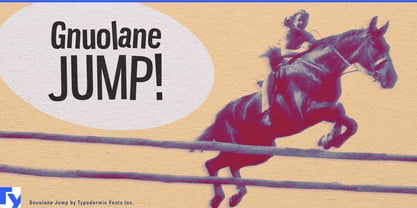
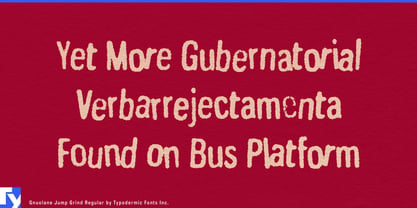

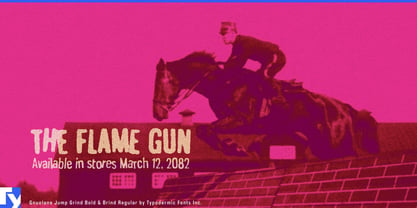
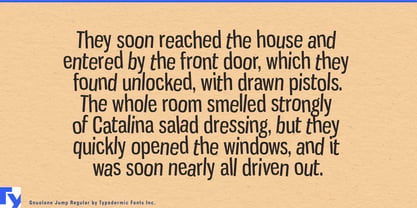
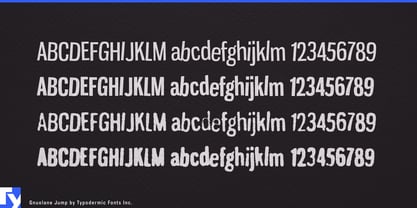
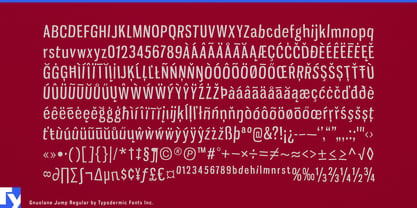
- Aa Glifos
-
¡Mejor PrecioPaquetes de familia
- Estilos individuales
- Especificaciones técnicas
- Licencias
Por estilo:
$5.48
Paquete de 4 estilos:
$21.95
Sobre la familia Gnuolane Jump Fuente
Conozca Gnuolane Jump, un tipo de letra desenfadado que rebosa personalidad. Inspirado en los diseños grotescos de principios del siglo XX, Gnuolane Jump es un tipo de letra con un divertido toque sesentero. Su aspecto superelíptico le confiere un encanto único que lo distingue de otros titulares fuentes.
Gnuolane Jump incorpora números de estilo antiguo, lo que le confiere un atractivo vintage. Pero lo que realmente hace que esta fuente destaque son sus ligaduras OpenType. Con combinaciones a medida que sustituyen automáticamente secuencias de caracteres comunes, Gnuolane Jump crea un efecto de rebote que da vida a su texto.
Si busca un estilo más discreto, eche un vistazo a Gnuolane y Gnuolane Stencil. Pero si quiere inyectar un poco de diversión y personalidad a sus titulares, pruebe Gnuolane Jump. Su espíritu alegre y su carácter único añadirán un toque extra de encanto a su diseño.
Es compatible con la mayoría de los sistemas de escritura europeos basados en el latín, incluidas las siguientes lenguas. Afaan Oromo, afar, afrikaans, albanés, alsaciano, aromano, aimara, bashkir (latín), vasco, bielorruso (latín), bemba, bikol, bosnio, bretón, caboverdiano, criollo, catalán, cebuano, chamorro, chavacano, chichewa, tártaro de Crimea (latín), croata, checo, danés, dawan, dholuo, neerlandés, inglés, estonio, feroés, fiyiano, filipino, finés, francés, frisón, friulano, gagauz (latín), gallego, ganda, genovés, alemán, groenlandés, criollo guadalupeño, criollo haitiano, hawaiano, hiligaynon, húngaro, islandés, ilocano, indonesio, irlandés, italiano, jamaicano, kaqchikel, karakalpak (latín), casubio, kikongo, kinyarwanda, kirundi, kurdo (latín), letón, lituano, lombardo, bajo sajón, luxemburgués, maasai, makhuwa, malayo, maltés, maorí, moldavo, montenegrino, ndebele, napolitano, noruego, novial, occitano, osetio (latín), papiamento, piamontés, polaco, portugués, quechua, rarotongano, rumano, romanche, sami, sango, saramaccan, sardo, gaélico escocés, serbio (latín), shona, siciliano, silesio, eslovaco, esloveno, somalí, sorabo, sotho, español, swahili, swazi, sueco, tagalo, tahitiano, tetum, tongano, tshiluba, tsonga, tswana, tumbuka, turco, turcomano (latín), tuvaluano, uzbeko (latín), veneciano, vepsiano, võro, valón, waray-waray, wayuu, galés, wolof, xhosa, yapés, zapoteco zulú y zuni.
Diseñadores: Ray Larabie, Chikako Larabie
Editorial: Typodermic
Fundición: Typodermic
Propietario del diseño: Typodermic
MyFonts debut: Apr 27, 2010

Acerca de Typodermic
Bienvenido a Typodermic Fuentes, una animada fundición tipográfica con sede en Nagoya (Japón), fundada por el diseñador tipográfico canadiense Raymond Larabie en 2001. Nuestra biblioteca está repleta de más de 500 tipos de letra diferentes para impulsar la creatividad en el diseño gráfico, la publicidad, la web y el desarrollo de app . Como pioneros de la tipografía digital, adoptamos pronto las licencias de fuentes y app , ampliando constantemente los límites del diseño. Con corazón canadiense y precisión japonesa, somos sus socios globales en tipografía extraordinaria. Descubra Typodermic Fuentes, donde la creatividad se une al carácter.
Seguir leyendo
Leer menos